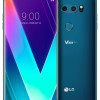Review: LG V30
The V30 comes so close to being a perfect smartphone, but it falls short in a few categories that ultimately hold it back a bit.
The hardware is impressive. The silky smooth glass, finely crafted aluminum, and tight assembly give the V30 a leg up on the iPhone when it comes to design and build. I'm pleased with the screen. The 18:9 aspect ratio is great and the practically bezel-free experience is clearly the future of mobile devices.
The V30's performance in several core behaviors is puzzlingly uneven. The device does a great job with data speeds and call connections, but doesn't produce enough volume for actually hearing those calls. The battery has more than enough capacity, and yet it isn't able to reliably deliver a full day under intense use. You can tweak the settings to get what you need, but you shouldn't have to.
The Snapdragon 835 processor pushes performance to the max, but I still saw some screen lag. The Android user interface is flexible, if a bit much at times. The camera application has lots of fun options, though making the most of them requires some practice. The V30 takes excellent images as long as you have plenty of light.
As it stands, the V30 is a viable alternative to the iPhone 8/Plus or Note8. There's no doubt the hardware is just as good as Apple and Samsung's and the compact footprint makes it easier to use day in and day out. If battery life and low-light performance were just a hair better each, I'd call it one of the best devices on the market.
The V30 costs $800.



 Best of IFA 2017
Best of IFA 2017
 Hands On with the LG V30
Hands On with the LG V30
 LG's V30S ThinQ to Cost $930
LG's V30S ThinQ to Cost $930
 AT&T's LG V30 Wins an Oreo Treat
AT&T's LG V30 Wins an Oreo Treat
 LG's V30S ThinQ Adds Color, Memory, Storage, Camera Smarts
LG's V30S ThinQ Adds Color, Memory, Storage, Camera Smarts
 LG V30
LG V30



